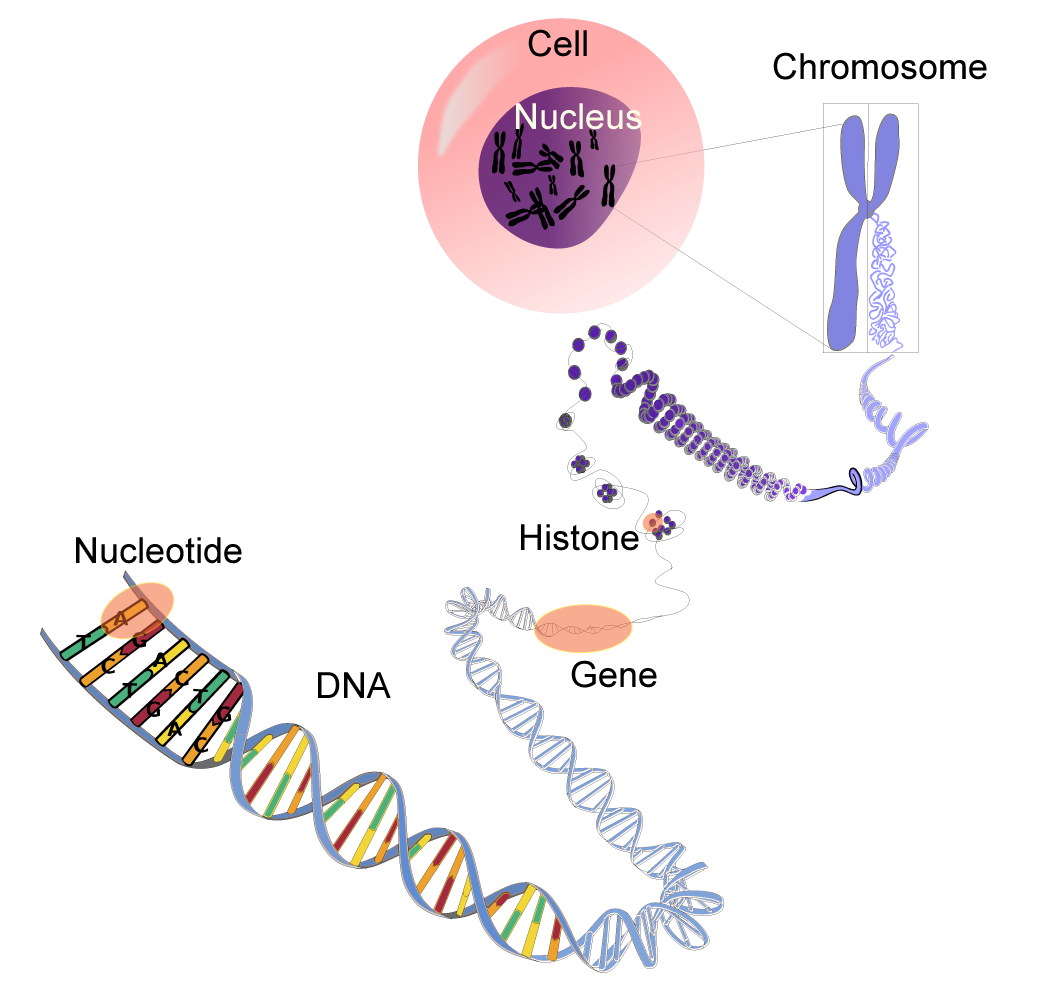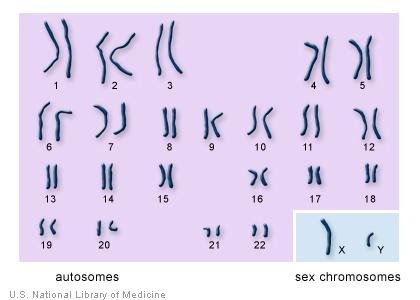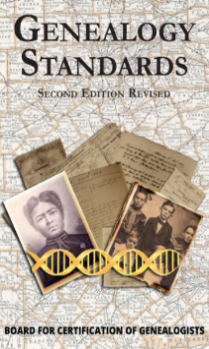A Beginner’s Guide to DNA
DNA Definitions
atDNA: autosomal DNA
cM: centimorgans, a measurement of genetic distance
IBD: Identical by Descent or a true match
IBS: Identical by State or a segment that is too common to be genealogically relevant.
MRCA: Most Recent Common Ancestor
MRCC: Most Recent Common Couple
Figure 2. Chromosomes and Deoxyribonucleicacid.
Figure 1. Humans have 23 pairs of chromosomes.
DNA Inheritance
There are four types of DNA tests: autosomal DNA, mitochondrial DNA, Y-DNA, and X-DNA. Each type of DNA has a unique inheritance pattern. The most common DNA test is atDNA, ex. Ancestry or MyHeritage.
DNA segments are measured in centimorgans (cM), a measurement of genetic distance.
The higher the cM shared with a match, the closer the family relationship is. For example, the cM shared with a parent range from 2,376 - 3,720 cM, but for second cousins the range is 42 - 592 cM.
Humans have two copies of each chromosome – one from the father and one from the mother.
The autosomal chromosomes undergo recombination during meiosis, meaning there is an exchange of DNA segments between the maternal and paternal copies of the chromosomes.
Figure 3. Chromosomes exchange segments during meiosis in a process called recombination.
Each person inherits DNA from all four grandparents, but due to recombination, they do not receive an exact 25% from each grandparent. The more generations you go back, the higher the chance is that you will not share autosomal DNA with all your 3rd cousins, 4th cousins, etc.
Autosomal DNA Testing Comparison Chart
Information from https://isogg.org/wiki/Autosomal_DNA_testing_comparison_chart
DNA Evidence
According to Genealogy Standards, genealogists need to address all relevant variables of evidence to fully analyze DNA test results.
Board for Certification of Genealogists, Genealogy Standards, 2nd ed. (New York: Turner Publishing Company, 2019), 30
Accuracy, completeness, and depth of each tree included in the analysis
The possibility of more than one common ancestor for each pair of DNA test takers
Reported and typical amounts of shared DNA
Sizes and locations of chromosome segments
Information about tested mutations, markers, or regions
Numbers and genetic relationships of people who were tested
Composition of genetic groups, including triangulated groups
Thoroughness of relevant documentary research
Principles Behind DNA Evidence
Your DNA test results include a list of your DNA matches.
The more cM you share with a match, the closer your relationship is.
Two of the most useful pieces of DNA evidence are these:
your DNA shared match groups
your triangulated segment groups.
A group of Shared Matches forms a genetic network.
If you have multiple DNA matches in a shared match group (genetic network), you can identify the Most Recent Common Couple (MRCC) you all descend from by building out the trees of your DNA matches.
Research Example
Research Question: Who are Sarah’s parents?
Research Answer:
All of these Shared Matches descend from William and Martha Marcus.
Documents found for Susannah Marcus named her parents.
DNA can lead to additional records to research.
The Shared cM Project on DNAPainter
The Shared cM Project tool estimates relationships between two DNA matches based on the number of shared centimorgans in the match.
The number below the title of the relationship represents the average number of cM shared for the given relationship.
The two numbers below the average represent the range of possible shared centimorgans for a particular relationship.
Enter the number of cM you share with a match into the top box.
The Shared cM Tool highlights the possible relationships.
Figure 5. The Shared cM Project Tool
Jonny Perl and Blaine Bettinger, “The Shared cM Project 4.0 tool v4,” DNA Painter (https://dnapainter.com/tools/sharedcmv4 : accessed 4 November 2022.)
Organizing and Researching your DNA Matches
IMPORTANT TIP: If your own tree is built out first with your direct-line ancestors and your collateral lines, it makes it easier for you and the DNA tools to identify how you relate to your DNA matches.
Step 1: Create eight DNA groups on Ancestry, MyHeritage, or in Microsoft Excel for your great-grandparents.
If you don’t have a big tree or thousands of DNA matches, you could start with four groups for your grandparents.
Name the groups with the surnames of the parents of your great-grandparent.
When you group your matches, these eight groups would include all surnames further back on that great-grandparent line.
If a great-grandparent is unknown, label the group “Father/Mother of…”
When choosing colors on Ancestry, the middle row has eight colors which are easy to distinguish and work well for your eight great-grandparents.
Use the first half of the middle row for your maternal lines and the second half for your paternal lines.
Use the remaining colors for research focus groups.
You can number your DNA groups to force the sort order you want.
Choosing colors on Ancestry
Step 2: Determine your research question (target ancestor) and create DNA focus groups for that research.
Name the DNA focus group after your research question, ex. “Wm Stoddard & Lydia Patterson.”
For misattributed parentage research, create Paternal Unknown 1, Paternal Unknown 2, etc.
Step 3: Group your DNA matches by starting with your first or second cousins on your DNA match list and place any “Common Ancestor” DNA matches into one or more of your DNA groups.
These become your reference group of known relationships for comparing shared matches later.
Group around 50 matches to research recent ancestors and 100+ DNA matches for more distant ones.
To get the Common Ancestor feature on Ancestry, you must attach your family tree to your DNA.
As you group your matches, add notes to each DNA match such as “Common Ancestors: Charles Stoddard & Anna Telford through son, John.”
You may share more than one common ancestor with a DNA match, even if the match’s tree does not show it.
NOTE: If you don’t find DNA matches to place in each of your eight groups, it may indicate there is no biological relationship to that line. Conversely, if you want to confirm a line, identify DNA matches to a mother’s maiden name.
Step 4: Add the closet matches (highest cM) to your target ancestor to a DNA focus group, using their Shared Matches. Continue with other close matches.
The number one tool for DNA research is the Shared Match tool.
NOTE: Ancestry’s Shared Match tool only goes down to 20 cM.
Step 5: Build quick trees for your DNA matches until you can find a MRCC. After finding a MRCC, verify each of the quick trees. These tools facilitate tree building:
Ancestry Trees with Hints
Ancestry’s ThruLines Tool or MyHeritage Theory of Family Relativity
Use FamilySearch Family Tree, Ancestry’s Public Member Trees, etc. to check for existing research.
Search your DNA matches for the surname you are looking for, especially if it is not a common surname.
TIP: You can create one Ancestry tree named “DNA Matches” to build multiple quick trees for your DNA matches.
Each time you start a new tree for a DNA match, add the first person to your existing tree and then “unlink” the relationship.
This allows you to have multiple, unconnected trees in one master “DNA Matches” tree.
Make sure the tree settings are “private and unsearchable.”















